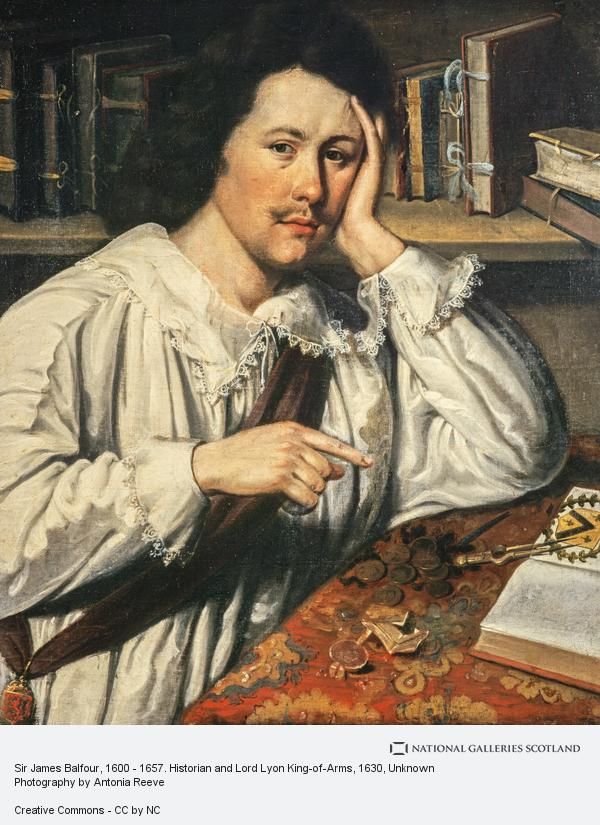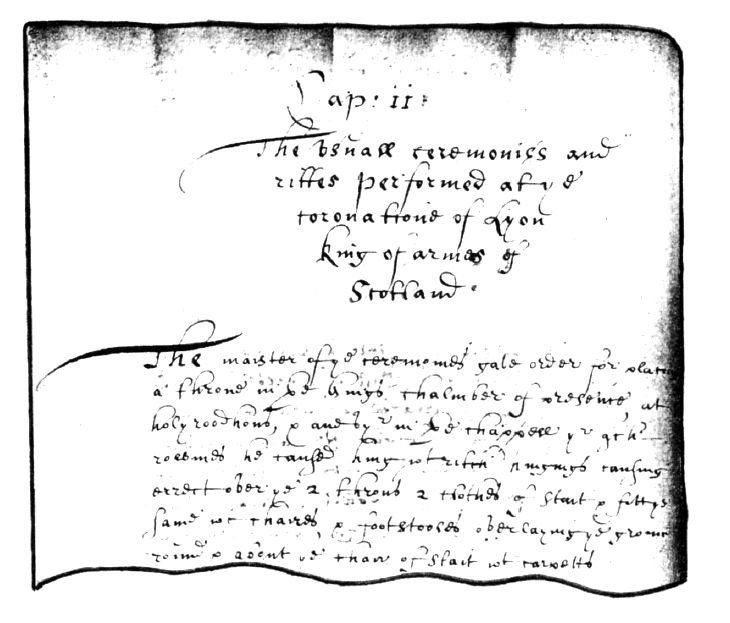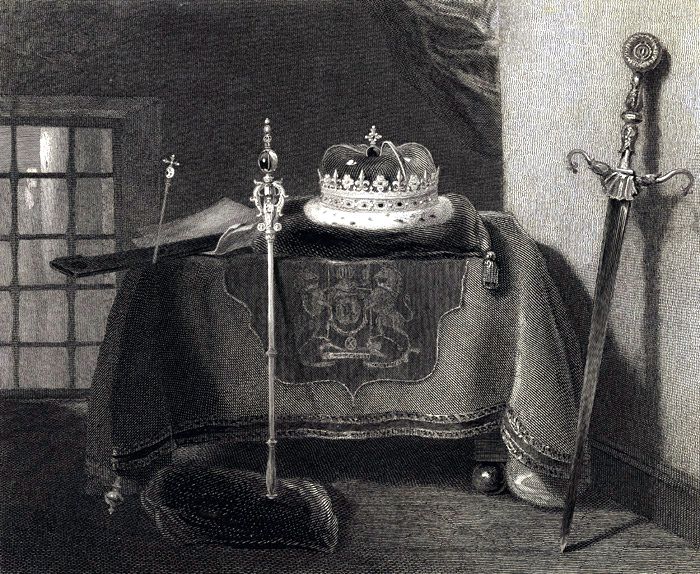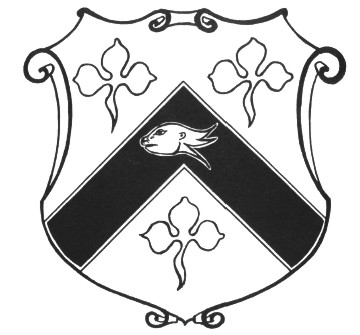 Sir James Balfour of Denmylne by an unknown artist (Courtesy of the Scottish National Portrait Gallery)
Sir James Balfour of Denmylne by an unknown artist (Courtesy of the Scottish National Portrait Gallery)
The Armorial in the above portrait, which is open to display Sir James’ own Arms, may be the “perfyte booke of arms” he was ordered to make by the Privy Council (Register, 2nd Series IV p6). The drawing instrument (dividers) lying on the volume tends to give weight to this suggestion. Sir James is wearing the Lyon badge on his right hip, dependent from a purple riband across his left shoulder. The badge depicts the Royal Arms of Scotland, ‘the ruddy lion ramping in his field of tressured gold’.
The Man
Of the holders of the office of Lyon1, Sir James Balfour of Denmylne (Denmiln) was the fourteenth whose name is known.
He was granted the rank and style by King Charles I and crowned by the king’s commissioner on Sunday, 13 June 1630 in accordance with a royal warrant sealed on 20 April of that year having been knighted about two weeks later on 2 May. After just over a further three years he was advanced to the hereditary station of baronet but was deprived of his rank as an Officer of the Crown and of the Kingdom2 and hence virtute officii a King’s Lieutenant, by Cromwell around 1654.3
Balfour was born c 1600, the eldest son of Sir Michael, comptroller of the household of Charles I. A poet, translator and traveller in his early days, he later devoted himself to historical and antiquarian studies and also took a great interest in cartography.4 In time Balfour became “addicted to heraldry”5, and in 1628 went south to the College of Arms to “perfect himself”6 in the art under Garter Segar. He made the acquaintance of William Dugdale and Roger Dodsworth – contributing a brief account of the religious houses of Scotland to the Monasticon on which these two distinguished scholars were already working. Following his loss of office c 1654 he spent much of his retirement collecting manuscripts and writing the Annals of the History of Scotland 7 and numerous tracts. Sometime after his death in 1657 a major part of his collection was acquired by the Faculty of Advocates and is now housed in the National Library of Scotland. Sir James’ writings, although considered jejune by some scholars, contain many interesting records of the ceremonies in which he took part, including a document in which he describes the crowning of a Lyon King of Arms.

The Manuscript
The manuscript (now Adv.MS.31.3.18 in the National Library of Scotland) is a work of twenty-eight chapters dealing with heraldry, and contains interesting accounts of the office of the Lyon including the privileges of Scots King of Arms, his duties at royal coronations, marriages and christenings, the apparel worn when exercising his official duties, and so on. Chapter eleven is headed “The Usuall Ceremonies and Rittes performed at ye coronatione of Lyon King of armes of Scotland”.
The manuscript appears to be in the hand of Balfour8 and it is obvious that Sir James was describing his own coronation, not only from the date he mentions but also because he speaks of Adam (Bellenden) Bishop of Dunblane who held that See before translation to Aberdeen in the second half of the decade. It may also be suggested that the account was written sometime after the event for he says the king’s commissioner, George Hay, was Earl of Kinnoull, which he wasn’t until 1633. The manuscript was purchased by the Advocates’ Library at the sale of Balfour’s works in 1698.9
The Coronation
The account begins with the preparations for the ceremony in the Palace of Holyroodhouse – thrones being placed in the king’s chamber of presence and the chapel, together with rich hangings, cushions of cloth of gold, plus the display of the Honours of Scotland (Crown, Sword and Sceptre) the king’s royal robes, Lyon’s crown10, coat, order and baton of office together with letters patent of appointment.
At about seven o’clock in the morning of the coronation, Sunday 13 June 1630, George Hay, already referred to, Lord Great Chamberlain, and His Majesty’s Commissioner, attended by the Lord Treasurer, Privy Seal, Secretary of State, Justice Clerk and a great number of members of the nobility came in procession from his lodgings, through the Court, the trumpets sounding.
The procession entered the chamber of presence and the Commissioner was seated in the king’s chair under a cloth of state, the nobility standing on each side of him. Then came Sir James Murray, master of ceremonies for the day, who asked permission to begin the main event. This being given, Murray – attended by four officials bearing silver maces” – then called the heralds, and to them delivered Lyon’s crown, to be carried on a green cushion, his coat (tabard), his order (sash badge) and his baton of office.
 The Honours of Scotland, from an etching by Andrew Geddes, ARA (1783-1844).
The Honours of Scotland, from an etching by Andrew Geddes, ARA (1783-1844).
What now follows is a direct copy of the manuscript differing only in that I have modernised the spelling to permit easy reading and added the very minimum of punctuation where this seemed necessary.
First went Six trumpets12 sounding, Pursuivants 2 and 2 in order, Heralds in order, Lyons Honours each after other, Master of Ceremonies bearing in his hand the Lyons Patent. Then came the Lyon supported between 2 knights – Sir Henry Bruce master of the Ordnance on his right hand and Sir John Auchmoulie master of the Wardrobe on his left, then came the Nobility 2 and 2 in order and after them followed the Lord Commissioner with the Lord Treasurer on his right hand and the Lord Privy Seal on his left (the trumpets still sounding) through the Guard Chamber to the outer entry of the Chapel where they all made a Pause to the view of the people in the Court. And they in order entered the Chapel, all making at their entry 3 several low Courtesies by the chair of State.
The Master of Ceremonies having placed my Lord Commissioner in his Majestys Chair of state, he desired the Noblemen to take their own places and sit down, then conveyed he the Lyon to his seat prepared for him without, made the heralds who carried his honours stand and bear aloft all the sermon time, and the other heralds, pursuivants and trumpets he placed at the windows which overlook the court.
Then did the Master of Ceremonies with a low Courtesy to the Lord Commissioner lay down the Lyon’s patent before him and retired.
Thereafter began the Sermon preached by Adam, Bishop of Dunblane, Dean of His Majestys Chapel royal, which being ended and the blessing given, the Master of the Ceremonies desired the Nobility to approach near to attend on my Lord Commissioners pleasure, who go arrayed and rounded the chair of state.
Then the Master of Ceremonies went and took the Lyon by the hand and presented him to the Lord Commissioner who making his Courtesy stood a little aside until the Clerk of the Council read his Majestys commission aloud for the inauguration of the Lyon King of arms; that done, then kneels the Lyon down before the Lord Commissioner who caused him put both his hands betwixt his and took the oath of allegience and thereafter the Oath of a king of arms.
Then did the Master of ceremonies take the coat and asked my Lord Commissioner if it was his Lordships pleasure to invest the Gentleman therewith who, taking it in his hands, putting the same over the Lyons head saying “I Vest thee with this royal coat of thy Office which thou shall wear at all honourable and necessary occasions and at all actions of honour requisite in His Majestys service and shall keep the same free from all shame and blot of dishonour during all the days of thy lifetime”.
Thereafter the Master of Ceremonies taking the crown, delivered it to the Commissioner who put it on the Lyons head with all these words “I crown and create thee in his Sacred Majestys name and by virtue of his royal commission direct to me to inaugurate and crown the Lyon King of Arms through all the kingdom of Scotland and Islands thereto adjacent, with all the honour, dignities and privileges belonging to thy Office”.
Then did the Master of Ceremonies deliver to the Lord Commissioner the baton who put it into the Lyons hands with these words “That this baton of thy office in token of the commandment and regal authority his sacred Majesty thy Lord and Master hath given thee overall that bears his Majestys arms within the kingdom of Scotland and by the authority hereof to denounce war and proclaim peace to all Emperors, Kings, Princes, Dukesand free Estates, and to do the same as it becomes thy high place at all times and at all occasions as his Sacred Majesty shall direct you”.
Then did the Master of Ceremonies direct the Heralds, Pursuivants and trumpets to proclaim the Lyons title in the chapel, out of the windows, and through all the Court.
 The Arms of Sir James Balfour. Or on a chevron sable between three trefoils slipped vert an otter's head erased argent.
The Arms of Sir James Balfour. Or on a chevron sable between three trefoils slipped vert an otter's head erased argent.
This done the Master of Ceremonies delivered to the Lord Commissioner the patent who took the same and gave it to the Lyon saying “I deliver these Letters patent under His Majestys great seal as the warrant of thy place and office, which His sacred Majesty hath ordained me to give thee”.
Next did the Clerk of the Council read his Majestys warrant for the Lyons order which the Master of Ceremonies taking gave it to the Lord Commissioner and put it about the Lyons neck saying “I deliver thee this order in token of thy preceding before all knights and others of Lower degree and quality in this kingdom being thy masters Royal badge and favour to be worn by all the days of thy lifetime”.
Immediately thereafter did the Heralds and Pursuivants again proclaim with sound of trumpet the Lyons titles, which being done he arises from his knees, in an harangue begs leave of the Lord Commissioner to remember His Masters favour and bounty in proclaiming these several times aloud. “A Largesse of the most high and mighty Monarch Charles by the grace of God King of Great Britain, France and Ireland, Defender of the faith etc.” and thereafter the Heralds and Pursuivants did proclaim the same out at all the windows with the sound of trumpets and the Drums answering them from the court below.
Thereafter did the Lord Commissioner arise when singing the authorised Benedicat Deus, and together as he entered, he returned in that same order into the chamber of Presence and sits down in the chair of state, the Heralds, Pursuivants and trumpets going to the windows, the Lyon again craves leave to proclaim His Majestys bounty and Largesse which he did several 3 times being seconded by the Heralds, and thereafter the heralds did proclaim the Lyons titles.
Then did the Lyon again kneel down before the Commissioner, where taking him by the hands, he confirmed the oaths taken in the chapel, and their solemn vows to be a true and faithful servant of his master, which done the Lyon rises up and in a long speech to the Lord Commissioner renders him and the rest of the nobility many thanks for all their favours to him and again craves all their pardons once more to remember his Sacred Majesty, his Masters, bounty towards him, which he did three several times.
Then did the Lyon, in the presence of the Lord Commissioner take the oaths of all the Heralds and Pursuivants. Last of all the Lord Commissioner did arise from the chair of state and with a loud voice cried “God Bless the King” at which the trumpets sounded and the drums beat out in order as they entered and conveyed the Lord Commissioner to his lodgings.
Afterword
Sadly, just over fifty years later, the last coronation of a Lyon took place. The date was 27 July 1681, the place Holyroodhouse, the officer being Sir Alexander Erskine of Cambo, a young man of just eighteen years. Today the inauguration is a much simpler affair.
Acknowledgements
I wish to thank Mrs C.G.W. Roads, MVO, FSA Scot, Carrick Pursuivant, Lyon Clerk and Keeper of the Records who identified the manuscript from a brief reference I supplied from Fox-Davies’ Complete Guide, and led me to the portrait of her distinguished ancestor; Dr Ian G. Brown, FRSE, FSA, FSA Scot, the Assistant Keeper of the Manuscripts Division of the National Library of Scotland who provided a copy of the document; and Charles Burnett, KStJ, MLitt, FSAScot, Ross Herald, who not only answered various queries but very kindly read an early draft of the essay and prevented several errors. If any remain of these poor things they are mine own.
Thanks are accorded to the Trustees of the National Library for permission to reproduce a portion of Adv. MS 31.3.18, the Scottish National Portrait Gallery for the use of a photograph of Sir James’ portrait, and Historic Scotland for a copy of the engraving of the Honours attributed to Andrew Geddes (1783-1844).
References
- There is an oft-repeated statement that King Robert Bruce created a Lyon King of Arms in 1318, but this is open to considerable doubt. The story seems to have been originated in the fifteenth century by a sub-prior of Arbroath monastery, one William de Pitten¬weem. However, the Exchequer and other Records do not support the assertion and it is not until 1377 that the office of Lyoun Herauld is known to have existed (Exchequer Rolls, vol ii, p553). The style Lyon King of Arms came later still, perhaps not until the reign of James IV (1488-1513). Certainly on 8 October 1501 a Lyon King accompanied an embassy to England to arrange the marriage of the king to Princess Margaret, daughter of Henry VII.
- The title “Lord” prefixed to the styles of the High Officers of Scotland is probably a rendering of the Gaelic prefix àrd = high. (Judicial Review cited by Sir Thomas Innes of Learney in Scots Heraldry p8). In the case of Lyon its date of first usage is uncertain, but may well be from the end of the sixteenth century when Sir David Lyndsay of the Mount secundus was honoured by King James VI. It was recognised in Parliament on 4 June 1663.
- This date, given in the DNB, may be a little early. True, the Act of Union between Scotland and England had been passed by the Council of State in April 1654 but it did not reach the Statute Book until early 1657 shortly before Cromwell was proclaimed Lord Protector at the Canongate in Edinburgh. The tenure of Balfour’s successor as Lyon dates from 1658, Sir James having died during the previous year. It is, therefore, possible to suggest that Denmylne continued to execute the duties of Lyon until his demise, in spite of being deprived of the office.
- Although not himself a cartographer Balfour collected, and as a result saved the hand-drawn maps of another, an act much admired, particularly by the Dutch geographer Blaeu whose engraved maps of Scotland, based on the foregoing, were incorporated into the Theatrum Scotiae. that of Lorne being dedicated to Balfour, and decorated with his Arms.
- DNB. Vol 1. p974.
- A “testificate” dated 1628 in the names of Garter, “Clarentius”, Norroy. the “Heraulds” and “Pursevants” is copied into MS 31.3.18. and pays tribute to Balfour’s learning. A fairly detailed account of Balfour’s life by Mrs C. G. W. Roads (Balfour’s seven times great-grand-daughter) was published in The Double Tressure No 12 (1990) pp5-9. See also the DNB.
- Published in 1824.
- From a letter to the author from Lyon Clerk and Keeper of the Records, 16 January 1997, re Adv. MS 31.3.18.
- From a letter to the author from the Assistant Keeper of the Manuscripts Division, National Library of Scotland. 5 February 1997.
- In the following chapter of the manuscript Balfour describes the crown: “It is made close, all of beaten gold, after the model of the imperial crown of Scotland, not set with stones, but only enamelled, its cape being crimson velvet, doubled and uplaid with ermine”.
The Register of the Privy Council of Scotland (Second Series III p491) makes it clear that the replica was made specifically for Denmylne. He was thus the first Lyon so crowned, the actual circlet of the Scottish kings being used theretofore. It continued to be employed until a replacement to the modern English pattern was made for the use of Robert Auriol. Earl of Kinnoull in 1796. The motto on the English Kings’ crown. Miserere mei Deus, “God be merciful unto me” was altered in heraldic use by Sir Thomas Innes, Lord Lyon (1945-1969) to the more apposite Nemo me impune lacessit (Wha’ daur meddle wi’ me) “No one provokes me with impunity” which is that of both Scotland and the Most Ancient and Most Noble Order of the Thistle. The current heraldic practice is to surmount Lyon’s arms with the Crown of Scotland sans jewels.
- It is likely the macers were two of Council and two of Session.
- Most probably the six State trumpeters, given that on 20 April 1630 King Charles had instructed that Balfour be crowned “with all convenient diligence land] with all ceremony dew and requisite in als goodlie forme and maner and als solemnity in all respects as ever anie Lyoun King of Armes has beene crowned heeretofore”.
